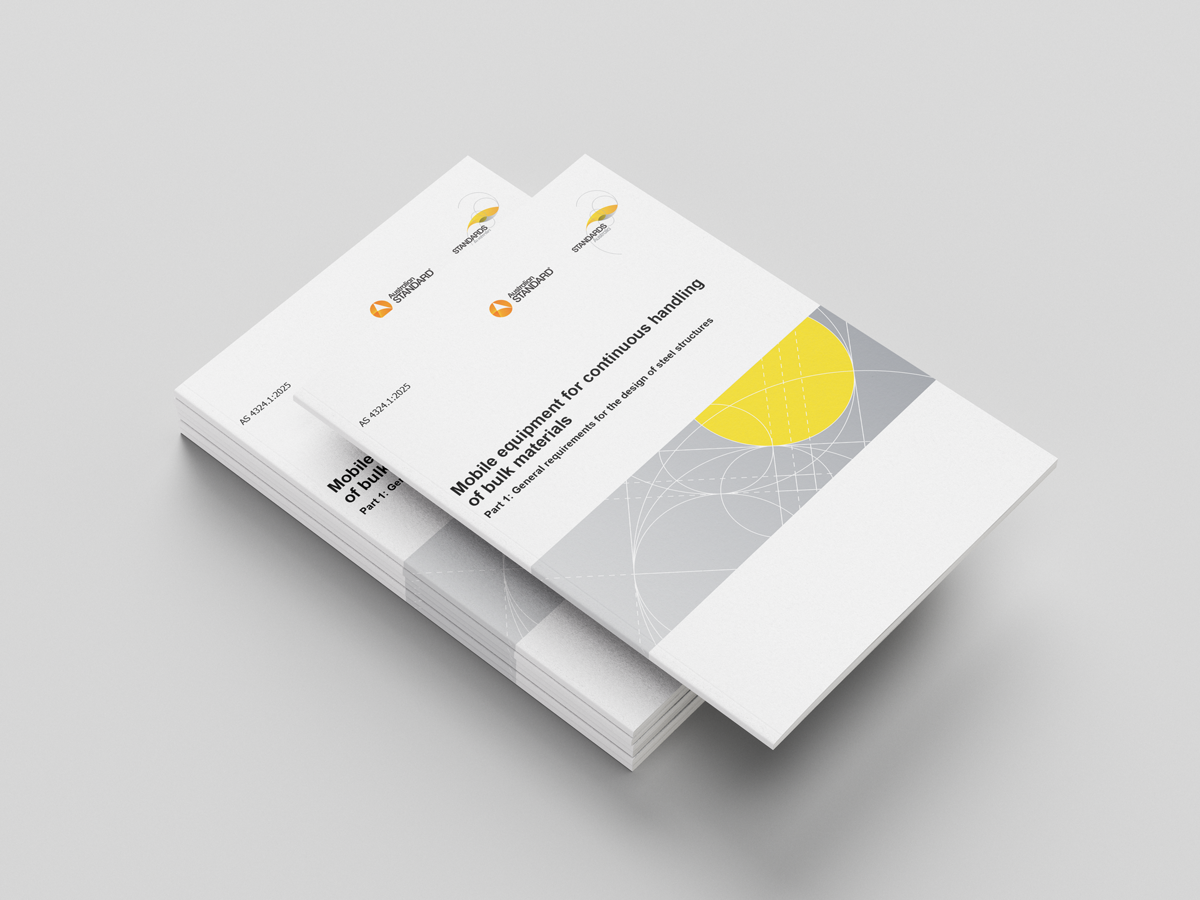Introduction
Standards Australia has just released Australian Standard AS 4324.1:2025, titled Mobile Equipment for Continuous Handling of Bulk Materials — General Requirements for the Design of Steel Structures. The standard was originally released in in 1995 with a revised version published in 2017. For 30 years, AS 4324.1 has played a foundational role in shaping the design, safety, and operational longevity of critical materials handling machines in Australia’s ports and mines.
This article provides a historical overview of the standard’s origins, rationale, development, major revisions, and current focus.
Jump to: Historical Context and Origins • Scope and Technical Philosophy • Revision History and Key Changes • Conclusion
Historical Context and Origins
The Drive for an Australian-Specific Standard
The push for a unique Australian standard originated from the late 1970s, reflecting Australia’s distinctive operating environments and increasing recognition of deficiencies within existing international standards when applied to the types and scale of machinery prevalent in the nation’s rapidly developing bulk export industries.
Two primary catalysts propelled the standard’s creation:
- A string of significant machinery failures and accidents, most notably a fatal collapse in Western Australia in 1993, underscored the inadequacy of solely relying on international or generic codes.
- The growing complexity and scale of Australian bulk materials handling plants — particularly in mining and export terminals — called for more exacting, comprehensive, and locally relevant design and procurement guidelines.
Committee Formation and Early Development
The formalization of work on AS 4324.1 began in 1978 with the Australian Standards Committee ME43. This committee drew upon wide-ranging expertise from across the mining, engineering, design, and operational sectors. Its initial objective: produce a broadly applicable standard for both continuous and intermittent bulk materials handling machines, compatible with the then newly released AS1418 standard for cranes.
Early on, the committee bifurcated into two groups: one focused on continuous equipment (e.g., bucketwheel excavators, reclaimers), and a second (deferred) aimed at intermittent machines such as draglines and shovels. Over the years, the development process was shaped by:
- The evolution of related Australian standards, particularly for structural steel (AS 4100) and mechanical equipment (AS 3990).
- The need to incorporate lessons learned from numerous high-cost failures globally and domestically, especially concerning load cases and fatigue.
- The intention to move from mere compliance with international codes (such as the de facto ISO5049.1) to the establishment of a robust, prescriptive Australian framework.
Influences and Predecessor Standards
Before the publication of AS 4324.1, international standards such as the German BG rules, DIN 22261, FEM rules, and ISO5049.1 heavily influenced machinery design in Australia. These standards, which arose primarily from German brown coal mining contexts, were adapted around the world and became the default for purchasing continuous bulk handling equipment in Australia, despite varying degrees of fit for local conditions.
However, committee ME43 consistently identified shortcomings, namely:
- A lack of comprehensiveness in addressing all relevant load scenarios and modern failure cases.
- Outdated or insufficient methodologies for fatigue, dynamics, and unique Australian operational challenges (e.g., wind and seismic loads).
- Excessive reliance on designer interpretation, risking inconsistent and occasionally under-engineered outcomes.
Australian Context and Adaptation
Australian engineering practice, by 1995, typically based contract specifications on ISO5049.1, supplemented by a patchwork of additional requirements tailored to address issues such as dynamic loads, fatigue, local environmental hazards, and more stringent safety expectations. The goal of AS 4324.1 was to codify these supplementary requirements into a coherent, comprehensive standard, reducing ambiguity and making high safety and performance expectations explicit within the design documentation itself.
Scope and Technical Philosophy
Broad Applicability
AS 4324.1 was designed for a wide range of continuous bulk materials handling machines, including:
- Bucketwheel and bridge reclaimers
- Stackers
- Shiploaders (bridge, portal gantry, portal slewing, and portal slewing/shuttling types)
- Excavators and ship unloaders
These machines typically feature combinations of long travel, slewing, luffing, and telescopic or shuttling mechanisms, all supporting continuous or high-intensity materials flow. The standard intentionally covered rail and crawler-mounted configurations and excluded fixed, intermittent, or small-scale machines outside the domain of major bulk operations.
Key Engineering Principles
AS 4324.1 established several foundational design principles, many of which differentiated it from predecessor codes:
- Conservatism in safety-critical design: The standard often requires higher factors of safety, more stringent fatigue, and redundancy provisions where failure could endanger life or lead to catastrophic machine loss.
- Explicit load case definition: Unlike the relatively flexible approach found in ISO5049.1, AS 4324.1 is highly prescriptive about load combinations, incorporating cases for rare but severe scenarios (e.g., boom collision, bucket wheel loss, buffer impacts, wind while untied).
- Preference for structural (not device-based) solutions: Wherever possible, integrity is required to be maintained even if electrical or mechanical protection devices fail or are bypassed, reflecting operational realities observed in past incidents.
- Integration of modern fatigue science: Fatigue was to be assessed under principles verified by contemporary research, explicitly referencing AS 4100 and modern international best practice (e.g., EN-1993-1-9, BS7608, International Institute of Welding guidelines), in contrast with legacy mean-stress or cycle-number band approaches.
Structural Design and Materials
AS 4324.1 specifies both permissible stress (AS 3990) and limit states (AS 4100) design methods, with corresponding references and requirements for stability, buckling, plate work, and connection design.
Later revisions simplified the acceptance of materials (e.g., automatic acceptance for AS 4100/AS/NZS 5100.6 compliant steels), but imposed additional ductility and toughness requirements for high-strength grades used in critical roles. Special provisions address limitations or additional testing for cold-formed members, particularly C450 SHS/RHS in welded zones.
Load Cases and Combinations
Load definition is at the heart of AS 4324.1. The standard details over 38 individual load components and their application via 22 principal load combinations, including various main, additional, and special loads. These are grouped by frequency (e.g., usual, occasional, and exceptional), with partial safety factors reflecting relative uncertainties. Key load scenarios addressed include:
- Standard and abnormal digging/lateral resistance
- Blocked chutes and flooded belts
- Permanent and non-permanent dynamics (including emergency braking)
- Wind (operational, relocation, and storm-tied)
- Impact events: travel skew, travel obstruction, boom collision, buffer impact
- Catastrophic component loss (e.g., bucket wheel, chutes)
- Burying by stockpile collapse
The approach is notably more prescriptive — requiring clear consideration and calculation for each relevant scenario, not simply reliance on safety devices or “as encountered” operational configurations.
Fatigue
AS 4324.1 mandates fatigue design to AS 4100, with cumulative damage assessment via Miner’s rule, adjusted for redundancy and inspection accessibility. Provisions are made for alternative recognised international assessment methods, but always focus on a reliable, science-driven, and auditable result.
Stability and Redundancy
Stability against overturning is quantified (Ms/Mo ratio), with explicit margins assigned to each load combination. For components such as wire ropes, stays, and hydraulic supports — particularly for booms with operator cabins — redundant systems are mandated, along with dynamic load consideration in event of a single failure.
Procurement and Audit
Recognising the “design and construct” nature of most machine procurements, AS 4324.1 provides guidance (especially in Appendices B and K) for specification writing and for independent third-party design audit, to ensure compliance from tender through detailed design, fabrication, erection, and commissioning.
Revision History and Key Changes
1995: First Edition
The inaugural standard codified many of the practices that had become common within the Australian industry, shifting explicitly from reliance on ISO5049.1 to a locally developed and enforced framework.
Key innovations included:
- Comprehensive, prescriptive load case taxonomy
- High standards for fatigue, with explicit guidance on load histories and stress ranges
- Introduction of redundancy and failure-case design for critical supports
2017: Major Revision
Prompted by ongoing industry experience and alignment with evolving Australian and international standards, the 2017 revision:
- Aligned limit states design requirements with AS/NZS 1170.0
- Modified safety factors for suspension/hydraulic supports
- Incorporated additional load cases
- Refined procurement, auditing, and specification writing guidance
- Allowed for fatigue verification using alternative international standards in addition to AS 4100.
2025: Revision
The 2025 edition, has been just released. Key changes include:
- Simplification of materials requirements to allow automatic acceptance of steel conforming to AS 4100 or AS/NZS 5100.6.
- Variation of the modified yield value for structural design.
- Modification and clarification of safety factors for suspension members and hydraulic cylinders.
- Addition of a new load case, ‘loss of chutes/telescopic chutes’.
- Addition of a new load case associated with wind loading applied to a machine ‘stranded from tiedown’.
- Modifications to clarify resistance to drifting requirements.
- Clarification and minor improvements to loading requirements and structural design rules.
- Modification to wording to align with contemporary Standards Australian Guidelines.
Since the 2017 revision, there have been several failures due to thunderstorm winds, and losses of chutes, prompting proposed additions to the standard to mitigate risks associated with such events. The wind standard AS/NZS 1170.2 has also been revised, affecting clauses in AS 4324.1.
Overall, the focus is on improving clarity, safety, resilience, and practical utility.
Conclusion
The history of AS 4324.1 is the story of a national industry learning from experience, engaging with international best practice, but ultimately demanding standards that match the high stakes and unique challenges of Australian bulk materials handling operations. Its successive revisions reflect a continuing journey toward improved safety, reliability, and structural excellence, with substantial benefits realised for operators, owners, designers, and — most importantly — those who depend on safe, efficient, and sustainable export industries.
References
- British Standards Institution (2015). BS 7608:2014+A1:2015 Guide to fatigue design and assessment of steel products Eurocodes (1993). Eurocode 3 EN 1993: Design of steel structures.
- German Institute for Standardization (2008). DIN 18800-3 (2008-11): Steel structures – Part 3: Stability – Safety against buckling of plates.
- International Electrotechnical Commission (2010). IEC 61508-1:2010 Functional safety of electrical/electronic/programmable electronic safety-related systems.
- Kang, W. H. et al. (2016) Reliability analysis for load factors in steel bulk material handling structures with respect to AS 4324.1. Australian Journal of Structural Engineering, 2016.
- Kang, W. H., Uy, B. (2018) Report to Mr Doug Hawkes Structural Integrity Engineering Pty Ltd, Reliability based factor-of-safety calibration for tensile element systems according to AS 4324.1:2017 and AS 4324.1:1995.
- Morgan, R. et al. (2016). Investigation of Revised AS 4324.1 Partial Load Factors for Steel Bulk Materials Handling Structures, ASEC 2016 Conference, Brisbane.
- Morgan, R. and Hawkes, D. (2024). Revision to Australian Standard AS4324.1-2017 for Materials Handling of Bulk Products. ASEC 2024 Conference, Melbourne.
- Morrison, W. R. B. et al. (1996). A New Australian Standard for Continuous Bulk Materials Handling Machines, National Conference on Bulk Materials Handling 30 September – 2 October 1996, Melbourne.

Richard Morgan is a Structural Engineer and Senior Advisor to Aspec Engineering with extensive experience in bulk materials handling and ports. He is chairman of Australian Standards Committee ME43 for materials handling machines. He is a Chartered Professional Engineer.
